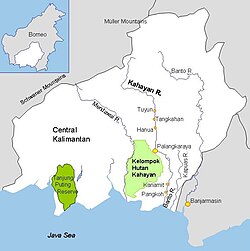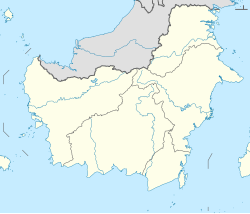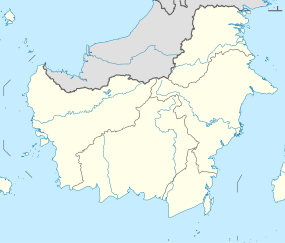geo.wikisort.org - River
The Barito River is the second longest river in Borneo after the Kapuas River with a total length of 1,090 km (680 mi) and with a drainage basin of 81,675 square kilometers (31,535 sq mi) in South Kalimantan, Indonesia. It originates in the Muller Mountain Range, from where it flows southward into the Java Sea. Its most important affluent is the Martapura River, and it passes through the city of Banjarmasin.[5][6]
| Barito River Sungai Barito, Sungai Dusun, Soengai Doesoen, Sungi Banjer, Sungi Dunsun, Soengai Baritoe, Sungai Banjar, Sungai Banjarmasin, Sungai Banjar Besar | |
|---|---|
 Barito and other rivers in Central and South Kalimantan | |
| Location | |
| Country | Indonesia |
| Physical characteristics | |
| Source | |
| • location | Müller Mountain Range |
| Mouth | |
• location | Java Sea |
• coordinates | 3°19′11.53″S 114°35′26.7″E |
• elevation | 0 m (0 ft) |
| Length | 1,090 km (680 mi) |
| Basin size | 81,675 km2 (31,535 sq mi)[1] |
| Width | |
| • minimum | 300 m (980 ft) |
| • average | 650 m (2,130 ft) to 1,000 m (3,300 ft) |
| • maximum | 2,000 m (6,600 ft) |
| Depth | |
| • minimum | 3 m (9.8 ft) |
| • average | 7 m (23 ft) to 8 m (26 ft) |
| • maximum | 25 m (82 ft) |
| Discharge | |
| • location | Barito Delta, Java Sea, Indonesia, Borneo (Kalimantan) |
| • average | 5,497 m3/s (194,100 cu ft/s)[1] (Period of data: 2003-2016)4,514 m3/s (159,400 cu ft/s)[2] |
| • maximum | 27,000 m3/s (950,000 cu ft/s) |
| Discharge | |
| • location | Banjarmasin (Basin size: 61,582 km2 (23,777 sq mi) |
| • average | (Period of data: 2006-2011)4,502 m3/s (159,000 cu ft/s)[3] |
| Discharge | |
| • location | Barito-Kapuas-Kahayan Delta (Basin size: 98,500 km2 (38,000 sq mi) |
| • average | 7,000 m3/s (250,000 cu ft/s) |
| Basin features | |
| Tributaries | |
| • left | Mangkatip, Negara River, Martapura River |
| • right | Murung River, Anjir Tamban, Anjir Serapat, Kapuas River (Barito River tributary)[4] |


This river is the location of the closest relative of the Malagasy language of Madagascar, the Ma'anyan language of Dayaks, from where settlers arrived in Madagascar (presumably in waves) from the 3rd to 10th century and from which the current island nation's population largely traces its origins.
Geography
The river flows in the southeast area of Borneo with predominantly tropical rainforest climate (designated as Af in the Köppen-Geiger climate classification).[7] The annual average temperature in the area is 24 °C (75 °F). The warmest month is October, when the average temperature is around 26 °C (79 °F), and the coldest is January, at 20 °C (68 °F).[8] The average annual rainfall is 2,735 millimeters (107.7 inches). The wettest month is December, with an average of 437-millimeter (17.2 in) rainfall, and the driest is September, with a 62-millimeter (2.4 in) rainfall.[9]
Images
- Dutch boat on the Barito River (1917)
- Inhabitants along the Barito
- A boat on the Barito
See also
References
- Strategi & Kebijakan Pengelolaan Wilayah Sungai Barito - Kapuas dalam Rangka Mendukung Pengembangan Kawasan Perkotaan yang Berkelanjutan (Slide deck) (in Indonesian) – via Scribd.
- Ting-Hsuan, Huang; Chen-Tung, Arthur Chen; Hsiao-Chun, Tseng; Jiann-Yuh, Lou; Shu Lun, Wang; Liyang, Yang; Selvaraj, Kandasamy; Xuelu, Gao; Jough-Tai, Wang; Edvin, Aldrian; G.S., Jacinto; Gusti Z., Anshari; Penjai, Sompongchaiyakul; B.J., Wang (May 2017). "Riverine carbon fluxes to the South China Sea: Riverine carbon fluxes to the SCS".
- Daniel, Stapper (2011). Artisanal Gold Mining, Mercury and Sediment in Central Kalimantan, Indonesia (PDF) (MS thesis). University of Victoria.
- M. K. Adamy (2 April 2012). "Sungai Barito Potensi Alam yang Diabaikan". Pemerintah Provinsi Kalimantan Tengah (in Indonesian). Archived from the original on 16 May 2017. Retrieved 8 January 2019.
- "Annette Delarbre". Tijdschrift voor Nederlandsch Indië (in Dutch). Vol. 1. Ter Lands-drukkerij. 1838. p. 6.
- Buddingh, Steven Adriaan (1861). Neêrlands-Oost-Indië: Reizen over Java, Madura, Makasser, Saleijer, Bima, Menado, Sangier-eilanden, Talau-eilanden, Ternate, Batjan, Gilolo en omliggende eilanden, Banda-eilanden, Amboina, Haroekoe, Saparoea, Noussalaut, Zuidkust van Ceram, Boeroe, Boano, Banka, Palembang, Riouw, Benkoelen, Sumatra's West-Kust, Floris, Timor, Rotty, Borneo's West-Kust, en Borneo's Zuid- en Oost-Kust; gedaan gedurende het tijdvak van 1852-1857 (in Dutch). M. Wijt. pp. 442.
de groote Banjersche rivier (de Barito).
- Peel, M. C.; Finlayson, B. L.; McMahon, T. A. (2007). "Updated world map of the Köppen-Geiger climate classification". Hydrology and Earth System Sciences. 11 (5): 1633–1644. Bibcode:2007HESS...11.1633P. doi:10.5194/hess-11-1633-2007. Retrieved 30 January 2016.
- "NASA Earth Observations Data Set Index". NASA. 30 January 2016. Archived from the original on 11 May 2020. Retrieved 8 January 2019.
- "NASA Earth Observations: Rainfall (1 month - TRMM)". NASA/Tropical Rainfall Monitoring Mission. 30 January 2016.
External links
 Media related to Barito River at Wikimedia Commons
Media related to Barito River at Wikimedia Commons
На других языках
- [en] Barito River
[es] Río Barito
El río Barito (en indonesio: Sungai Barito) es un largo río de Indonesia que discurre por la parte meridional de la isla de Borneo, uno de los mayores de la isla, y también de los ríos más largos localizados en una isla en el mundo (el mayor, en la misma isla, es el río Kapuas). Tiene una longitud de 890 km, que lo convierten en el segundo río del país, tras el ya mencionado río Kapuas.[it] Barito
Il Barito è un fiume dell'Indonesia situato sull'isola di Borneo, nella provincia di Kalimantan Meridionale. Con i suoi 880 km è il secondo fiume più lungo dell'Indonesia, dopo il Kapuas (1150 km).[ru] Барито
Бари́то[1][2][3] (индон. Barito) — река на индонезийской территории острова Калимантан. Протекает в основном по провинции Центральный Калимантан, в нижнем течении также по провинции Южный Калимантан, служа на некоторых участках их естественной административной границей. Впадает в Яванское море в районе города Банджармасин, образуя общую дельту с несколькими меньшими по размеру реками.Другой контент может иметь иную лицензию. Перед использованием материалов сайта WikiSort.org внимательно изучите правила лицензирования конкретных элементов наполнения сайта.
WikiSort.org - проект по пересортировке и дополнению контента Википедии




